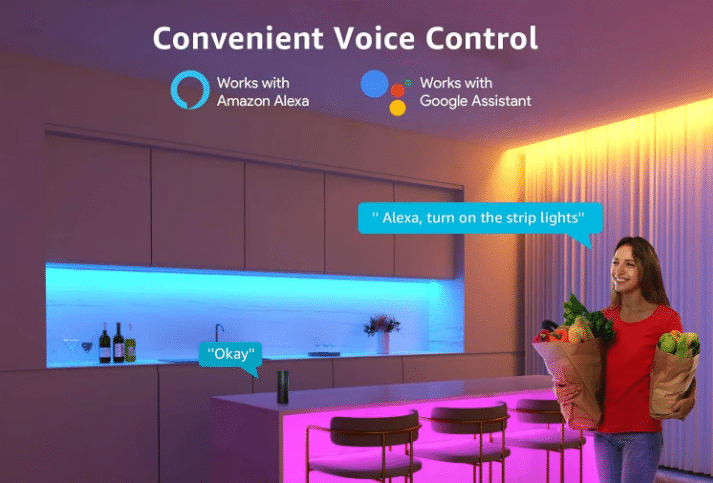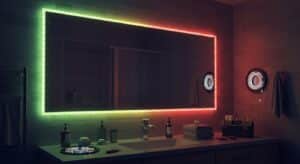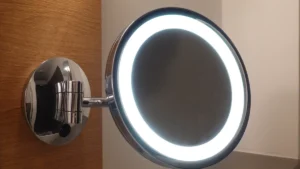
Choosing the right smart LED strip lights can change your home. They can make it cozy, colorful, or even futuristic. But how do you choose the best ones? Start by thinking about brightness, colors, and smart home features. Brightness is measured in lumens, which shows how well the lights brighten your space. More LEDs in a strip mean brighter lights, making them great for work areas or fun spaces.
Color temperature is important too. Warm white smart LED strip lights feel relaxing and cozy, while cool white lights make a room feel fresh and active. Don’t forget about smart features! Many smart LED strip lights work with Alexa or Google Home, allowing you to control them with your voice or an app. This makes using your lights easy and exciting.
Key Takeaways
Pick smart LED strip lights by how bright and warm they are. This helps set the right mood at home.
Find energy-saving options to save money and last longer. This means fewer replacements are needed.
Make sure they work with your smart home system. This allows easy control using voice or apps.
Check if the LED strips are strong and waterproof. This is important for outdoor or wet places.
Read reviews and check the brand’s reputation. This helps you choose wisely and avoid problems.
Understanding Smart LED Strips

What Are Smart LED Strips?
Smart LED strips are bendable lights that save energy and look cool. They have tiny LED lights on a sticky, thin strip. These lights are called “smart” because they connect to Wi-Fi or Bluetooth. You can control them with a phone app, voice commands, or smart systems. Use them to brighten rooms, set a mood, or add fun colors.
There are different types of smart LED strips. RGB strips show red, green, and blue colors, while RGBW adds white light. Some strips only show one color or adjustable white shades. Their flexibility makes them great for creative setups. You can stick them under cabinets, on stairs, or even outside.
Key Features of Smart LED Strips
Smart LED strips have cool features that make them special. Here are some:
Energy Efficiency: They use 75% less power than regular lights, saving money.
Customization: Pick from millions of colors to match your style or mood.
Durability: They last 25,000 to 50,000 hours, so you replace them less.
Smart Control: Connect them to Alexa or Google Home for easy control.
Dynamic Lighting: Enjoy smooth color changes, segment control, and brightness that adjusts to the time.
These features make smart LED strips both useful and stylish for your home.
Benefits of Smart LED Strip Lighting
Smart LED strips are more than just pretty lights. Here’s why they’re awesome:
Energy Savings: They use less power, cutting costs and helping the planet.
Longevity: They last longer, so you save money and create less waste.
Aesthetic Appeal: They make furniture pop or create a cozy vibe.
Flexibility: Bend them to fit tricky spots or make fun shapes.
Smart Integration: Connect them to your smart home for easy automation.
With their mix of style, smarts, and savings, smart LED strips are a great choice for any home.
Key Factors for Choosing Smart LED Strip Lights
Brightness and Lumens
When picking LED strip lights, brightness is very important. Brightness is measured in lumens, showing how much light the strip gives. For workspaces or kitchens, choose brighter lights for better visibility. Softer, dimmer lights work well for bedrooms or living rooms.
Different spaces need different lumen levels. For general lighting, aim for 450 lumens per meter. For task lighting, go for 800 lumens per meter. The type of LED chips also matters. High-quality chips give better light and save energy. Always check the product details before buying.
Tip: Choose LED strips that meet standards like IES LM-79-2008. These ensure accurate brightness and color quality.
Color Temperature and Options
The color temperature of LED strips affects the mood of your room. Warm white (2700K-3000K) feels cozy and is great for bedrooms or living rooms. Cool white (5000K-5700K) feels fresh and works well in kitchens or offices. Matching the color temperature with your other lights keeps your home looking consistent.
Some LED strips offer RGB or RGBW options. These let you pick from millions of colors. They’re perfect for creating fun or lively spaces. Whether you want a warm glow or party colors, there’s an LED strip for you.
Color Temperature | Mood Effect | Best For |
|---|---|---|
Warm (2700K-3000K) | Cozy and relaxing | Bedrooms, living rooms |
Cool (5000K-5700K) | Fresh and energizing | Kitchens, workspaces |
Smart Features and Control Methods
Smart LED strips have features that make them easy to use. You can control brightness, colors, and patterns with an app or voice commands. For example, say, “Alexa, dim the lights,” and watch your room change instantly. Connecting to systems like Google Home or Alexa adds convenience.
Some advanced options let you do more. You can change color temperature, set schedules, or sync lights with music. Some strips even let you light different sections in different colors. These features help you create lighting that fits your mood or activity.
Note: If you’re new to smart lights, start simple. Try basic dimming and color-changing features first. You can upgrade later!
Compatibility with Smart Home Systems
When picking smart LED strip lights, check if they work with your smart home system. They should connect easily to devices like Alexa, Google Home, or Apple HomeKit. This makes controlling your lights simple. For example, you can say, “Hey Google, turn on the living room lights,” and your room lights up right away. Isn’t that awesome?
Some smart LED strips can do even cooler things. They can sync with devices like thermostats or security cameras, making your home smarter. You can also use an app to change brightness, colors, or patterns from your phone. This makes using your lights fun and super easy.
Here’s why compatibility matters:
Feature | Benefit |
|---|---|
Integration with IoT devices | Works with gadgets like thermostats and cameras for better control. |
Voice and app-based control | Lets you manage lights in different ways, easily. |
Energy efficiency | Saves energy, helping you lower your electricity bills. |
Tip: Before buying, make sure the LED strips work with your smart home system. This avoids problems later.
Durability and Waterproofing
Durability is important, especially for outdoor or damp places like bathrooms. Look for LED strips with a good IP rating. This tells you how well they handle dust and water. For example, IP65 means they resist water splashes, while IP68 means they’re fully waterproof and can go underwater.
Here’s a guide to IP ratings:
IP Rating | Description | Waterproof Capability |
|---|---|---|
IP65 | Resists water jets but not submersion | Good for light splashes |
IP67 | Handles short submersion but not for long periods | Not for long underwater use |
IP68 | Fully waterproof, safe for deep water use | Great for underwater setups |
For outdoor use, pick IP67 or IP68-rated strips. They can handle rain and bad weather. Indoors, IP65-rated strips are fine for kitchens or bathrooms.
Power Supply and Installation Needs
The power supply is very important. Your LED strip lights need the right power source to work. Most strips use 12V or 24V power. To find the right power supply, multiply the power per meter by the strip’s length. For example, a 10W per meter strip that’s 5 meters long needs a 50W power supply.
Here are some simple installation tips:
Connect the power supply to the controller, then to the LED strip. This helps the controller manage multi-color strips like RGB or RGBW.
Make sure the power supply gives enough power for the strip. This keeps the lights working smoothly.
If you want wall control, you might need extra smart switches since the strip doesn’t connect directly to the wall.
Pro Tip: Always check if the power supply works with your LED strip lights. This stops problems like flickering or overheating.
A Guide to Choosing Smart LED Strips for Your Needs
Mood Lighting for Living Spaces
Smart LED strip lights make living spaces cozy and welcoming. Use them to brighten furniture, add soft wall glows, or create a relaxing movie night vibe. You can change brightness and colors to match any mood. Want a warm, calm feel? Pick soft yellow or orange shades. Throwing a party? Go for bright colors like blue or purple.
Colors affect how you feel. Warm tones (2700K-3000K) feel cozy, while cool tones (4000K-5000K) boost energy. Smart LED strips let you switch between these easily using your phone or voice. They’re flexible too—place them under shelves, around mirrors, or behind TVs for a modern look.
Feature | Description |
|---|---|
CCT Importance | Color temperatures affect emotions, adding comfort or energy. |
Customization | Change brightness and colors for unique atmospheres. |
Versatility | Great for accent lighting or stylish setups. |
Tip: Highlight features like alcoves or crown molding with smart LED strips for added style.
Task Lighting for Work Areas
Smart LED strip lights are great for focused work or study lighting. They give bright, direct light to help you stay productive. Whether reading, cooking, or crafting, these lights provide enough brightness without eye strain.
LED strips save energy and last long, making them perfect for task lighting. Install them under kitchen cabinets, on desks, or in workshops. Adjust brightness to fit your needs—dim for relaxing or bright for detailed tasks.
LED strips are ideal for workspaces at home or offices.
They offer focused light for tasks like reading or cooking.
Their energy-saving design makes them affordable and durable.
Pro Tip: Pick LED strips with at least 800 lumens per meter for work areas. This ensures proper lighting for detailed activities.
Outdoor and Waterproof LED Strip Lighting
Outdoor areas can shine with smart LED strip lights. These lights are built to handle weather, making them great for patios, gardens, or pools. Look for high IP ratings like IP65 or IP68. IP65 handles splashes, while IP68 works underwater.
Durability is important outdoors. Some strips, like resin-coated ones, resist water and grease. They’re perfect for kitchens, patios, or outdoor stairs. Control them remotely to adjust brightness and colors for outdoor events.
IP65 lights resist splashes, perfect for patios or decks.
IP68 lights are waterproof, great for pools or fountains.
Resin-coated strips work well in wet or greasy spots.
Note: Always check the IP rating before buying outdoor LED strips. This ensures they’ll last in your chosen space.
Accent Lighting for Home Decor
Smart LED strips can make your home decor stand out. Use them to highlight features like crown molding, shelves, or artwork. This draws attention to details and makes your space look stylish.
These lights are super flexible. Put them under cabinets, along stairs, or behind furniture for a soft glow. This creates depth and makes rooms feel cozy and inviting. You can also change colors to match your mood or event. Hosting dinner? Choose warm tones. Game night? Pick bright, fun colors.
Here’s why accent lighting is great for decor:
It shows off cool features like textured walls or alcoves.
It adds a warm, welcoming feel with soft lighting.
You can play with colors and brightness for a unique look.
Smart LED strips let you adjust color temperature (CCT) too. Cool white is great for reading, while warm tones are better for relaxing. This makes them perfect for any room.
Tip: Frame mirrors or headboards with smart LED strips for a modern touch. It’s an easy way to upgrade your decor affordably.
With smart LED strips, you’re not just lighting your home—you’re giving it character.
Installation and Maintenance of Smart LED Strip Lights

Step-by-Step Installation Guide
Installing smart LED strip lights might seem tricky, but it’s easier than you think. Follow these steps to get it right the first time:
Prepare the Surface: Start by cleaning the area where you’ll place the lights. Use a damp cloth or isopropyl alcohol to remove dust and grease. Let it dry completely.
Test the Lights: Before sticking them on, plug in the LED strip and check if all the lights work. This saves you from redoing the installation later.
Measure and Cut: Measure the space carefully. If needed, cut the strip along the marked lines to fit your area. Never cut outside these marks.
Attach the Strips: Peel off the adhesive backing and press the strip firmly onto the surface. Avoid creating folds or bubbles.
Connect to Power: Attach the strip to the power source. Ensure all connections are secure and match the polarity. Once connected, turn it on to confirm everything works.
Tip: Sketch out your layout before starting. This helps you avoid surprises during installation.
Tips for Proper Placement and Adhesion
Proper placement makes your LED strips look sleek and last longer. Here’s how to do it right:
Measure First: Always measure the area to ensure the strip fits perfectly. This avoids cutting errors.
Clean the Surface: A clean surface is key for strong adhesion. Use mild soap or rubbing alcohol to remove dirt and grease.
Use Mounting Clips: For rough or uneven surfaces, mounting clips provide extra support and keep the strip secure.
Avoid Overheating: Place the strips in areas with good airflow. This prevents overheating and extends their lifespan.
Note: If you’re installing strips in damp areas like bathrooms, choose waterproof LED strips with a high IP rating.
Maintenance Tips for Longevity
Smart LED strip lights are durable, but a little care goes a long way. Follow these tips to keep them shining bright:
Clean Regularly: Dust can dim the lights over time. Wipe the strips gently with a soft, dry cloth.
Control Brightness: Use dimming features to reduce strain on the LEDs. This helps them last longer.
Avoid Frequent Switching: Turning the lights on and off too often can shorten their lifespan. Use smart controls to automate usage.
Check Connections: Inspect the power supply and connections periodically. Loose wires can cause flickering or damage.
Pro Tip: Keep the operating temperature stable. Overheating can reduce the efficiency and lifespan of your LED strips.
With proper installation and maintenance, your smart LED strip lights will enhance your home for years to come.
Additional Considerations for Smart LED Strip Lighting
Budget and Cost-Effectiveness
When choosing smart LED strip lights, it’s important to think about both the upfront cost and long-term savings. While these lights might seem pricey at first, they’re actually a smart investment. Why? They use way less energy than traditional lighting, which means lower electricity bills. Plus, they last much longer—up to 25 times more than regular bulbs. This means fewer replacements and more savings over time.
Here’s a quick breakdown of why they’re cost-effective:
Energy Efficiency: Smart LED strips consume at least 75% less energy than incandescent lights.
Long Lifespan: They can last tens of thousands of hours, reducing replacement costs.
Smart Features: Integration with smart home systems helps you manage energy use better.
If you’re worried about the initial cost, think of it this way: the money you save on energy and replacements will more than make up for it. It’s a win-win for your wallet and the environment.
Brand Reputation and Warranty
Not all LED strip lights are created equal. That’s why it’s smart to stick with trusted brands. A good brand often means better quality, durability, and performance. Look for companies that have positive reviews and industry recognition. Awards or mentions from experts can tell you a lot about a brand’s reliability.
Warranties are another big deal. A solid warranty shows that the manufacturer believes in their product. Some top brands even offer extended warranties, giving you peace of mind. If something goes wrong, you’ll know you’re covered. So, when shopping for LED strip lights, don’t just look at the price—check the brand’s reputation and warranty too.
Importance of User Reviews
User reviews are like a sneak peek into what you’re buying. They give you real-world insights into how the LED strip lights perform. Are they easy to install? Do they last as long as promised? Reviews can answer these questions and more. Look for patterns in the feedback. If many people mention the same issue, it’s probably something to consider.
Positive reviews often highlight things like brightness, durability, and smart features. On the other hand, negative reviews can warn you about potential problems. Don’t skip this step—it’s like having a guide to help you make the best choice. After all, who better to trust than people who’ve already tried the product?
Picking smart LED strip lights can make your home look amazing. Focus on brightness, color choices, and how they work with smart systems. These lights save energy and last long, making them a smart buy. New features let you change settings to match your style.
Think about what you need. Use bright lights for work or soft ones for decor. Good-quality LED strips improve your home’s look and cut energy costs. This guide helps you choose wisely and enjoy smart lighting benefits.
FAQ
What are the best places to install smart LED strip lights?
You can install them under cabinets, behind TVs, along stairs, or around mirrors. They also work great for outdoor spaces like patios or gardens. Their flexibility makes them perfect for creative setups anywhere in your home.
Tip: Highlight crown molding or shelves for a stylish touch.
Can I cut smart LED strip lights to fit my space?
Yes, most LED strips have marked cutting points. You can trim them to fit your space. Always check the product instructions before cutting to avoid damaging the strip.
Note: Use scissors to cut only at the designated points.
Do smart LED strips work without Wi-Fi?
Some do! Many strips connect via Bluetooth, so you can control them without Wi-Fi. However, Wi-Fi-enabled strips offer more features like voice control and remote access.
How do I choose the right brightness for my room?
Match the brightness to the room’s purpose. For workspaces, go for 800 lumens per meter. For cozy areas like bedrooms, softer lighting around 450 lumens per meter works best.
Room Type | Recommended Brightness |
|---|---|
Workspaces | 800 lumens per meter |
Bedrooms | 450 lumens per meter |
Are smart LED strips safe for outdoor use?
Yes, but only if they have a high IP rating like IP65 or IP68. These ratings ensure they can handle water and dust. Always check the product details before using them outdoors.
Pro Tip: Use IP68-rated strips for pools or fountains.
See Also
Selecting The Perfect LED Strip Lights For Linear Lighting
Choosing The Ideal RGB LED Strip For Your Requirements
Top Five Tips For Selecting The Best LED Strip Lights
Utilizing Smart LED Strips For Home Lighting In 2025
Deciding On 2835, 3528, Or 5050 LED Strip Options



